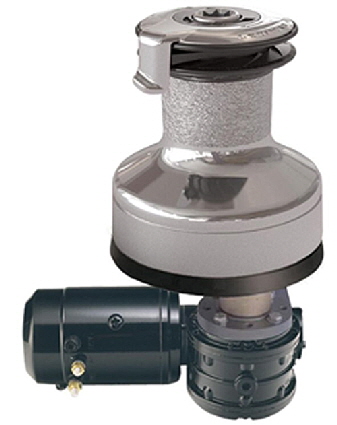
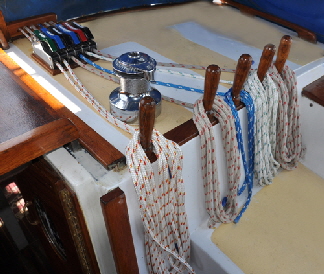 After I bought my 50’ foot schooner Britannia I decided to fit as many systems as I could afford to make handling the big 22-ton boat easier. I made an electric hoist to lift the heavy RIB up on its davits; a crane to hoist the outboard; a powerful anchor windlass, etc. I also converted all five sails to roller-furling, and routed twelve control lines back to the safety of the center cockpit to minimize deck work. I then fitted self-tailing winches and rope clutches on either side of the companionway to handle all the lines, that we now call “the rope decks”. This of course, meant an awful lot of manual winch winding, so after dismissing fixed electric winches due to their horrendous cost, (the header picture shows a regular electric winch), I began to think about portable electric winch winding devices.
After I bought my 50’ foot schooner Britannia I decided to fit as many systems as I could afford to make handling the big 22-ton boat easier. I made an electric hoist to lift the heavy RIB up on its davits; a crane to hoist the outboard; a powerful anchor windlass, etc. I also converted all five sails to roller-furling, and routed twelve control lines back to the safety of the center cockpit to minimize deck work. I then fitted self-tailing winches and rope clutches on either side of the companionway to handle all the lines, that we now call “the rope decks”. This of course, meant an awful lot of manual winch winding, so after dismissing fixed electric winches due to their horrendous cost, (the header picture shows a regular electric winch), I began to think about portable electric winch winding devices.
A portable battery operated winch winding machine that fits into the top of a regular winch will effectively “electrify” all a boats winches, and save a lot of winding by hand. They are not as simple to use as a fixed electric winch at the press of a button, but even converting just the cockpit winches on Britannia would cost about $20,000, and that would still do nothing for the other six on the two masts, so 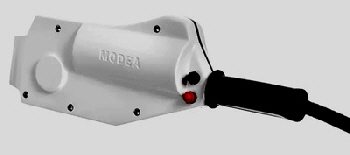 for me that was never an option.
for me that was never an option.
The early winch winders went under names like Winch Master, Winch Buddy, and Modea. They were not battery powered and had long cables that needed connecting to a 12-volt battery - 13 feet long in the case of the Modea, which restricted their use outside of the cockpit.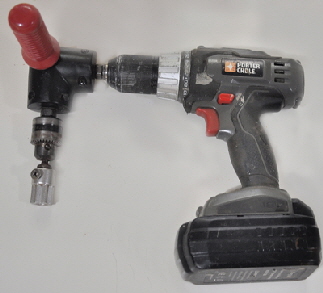 I made an electric winder myself, by using a simple right-angle-drill adapter on a power drill, with an eight-point sprocket in the chuck, that fits into all my winches. It worked okay, but the battery expired quite quickly and had to be changed a number of times. It was also not very powerful and I usually had to finish off the sheets by hand winding a regular handle. Indeed, there were many shortcomings, but better than hand-cranking.
I made an electric winder myself, by using a simple right-angle-drill adapter on a power drill, with an eight-point sprocket in the chuck, that fits into all my winches. It worked okay, but the battery expired quite quickly and had to be changed a number of times. It was also not very powerful and I usually had to finish off the sheets by hand winding a regular handle. Indeed, there were many shortcomings, but better than hand-cranking.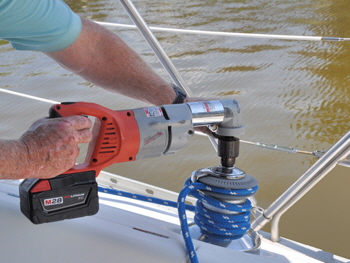 Next, I bought a Milwaukee M28 90-degree cordless drill, but that was the opposite, it was much too powerful! and I had to be very careful to avoid having it wrenched out of my hands if the rope jammed, and there was also the chance of snapping a line or damaging a sail. This drill is also very heavy and actually designed for construction workers to drill sideways holes in wood frameworks, to pass wires through. There are now a few other makes of right-angle drills that are smaller and lighter that would be better choices, but never as good as a purpose-made battery powered winch winder.
Next, I bought a Milwaukee M28 90-degree cordless drill, but that was the opposite, it was much too powerful! and I had to be very careful to avoid having it wrenched out of my hands if the rope jammed, and there was also the chance of snapping a line or damaging a sail. This drill is also very heavy and actually designed for construction workers to drill sideways holes in wood frameworks, to pass wires through. There are now a few other makes of right-angle drills that are smaller and lighter that would be better choices, but never as good as a purpose-made battery powered winch winder.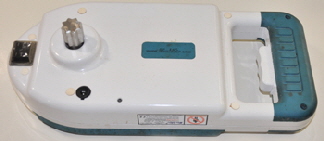 In 2010 the Winchrite was exhibited for the first time at the Fort Lauderdale boat show, and I immediately saw the advantages over my poor efforts, so I bought one for $510 – they are now $973. This was the first purpose-designed battery operated winch winding device, with an easy to grip handle and proportional and reverse speeds from a powerful electric motor. Winchrite was a vast improvement on all previous devices and was completely portable for use on other things like winding a dinghy up on davits. Unfortunately the battery is built-in, so when it dies the machine can't be used again until it is re-charged.
In 2010 the Winchrite was exhibited for the first time at the Fort Lauderdale boat show, and I immediately saw the advantages over my poor efforts, so I bought one for $510 – they are now $973. This was the first purpose-designed battery operated winch winding device, with an easy to grip handle and proportional and reverse speeds from a powerful electric motor. Winchrite was a vast improvement on all previous devices and was completely portable for use on other things like winding a dinghy up on davits. Unfortunately the battery is built-in, so when it dies the machine can't be used again until it is re-charged. 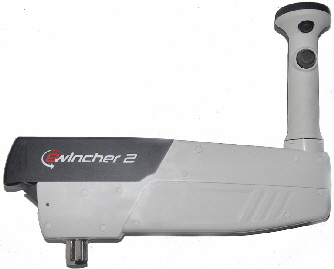 My next device was the French Ewincher2. This is an ergonomic design with a vertical handle similar to a manual handle, and with interchangeable lithium-ion batteries. This was a great leap forward because when the battery begins to die – always when you are using it of course - a new one can be inserted without even taking the machine out of the winch. It also has a number of other innovations. (1) The drive sprocket locks in a winch automatically, which is very important when using it in a horizontally mounted mast winch. (2) The turning circle is only 11” inches, the same as regular winch handles, so when the Ewincher2 is turned by hand it won't interfere with anything else in the cockpit, like a Bimini strut, which the massive Milwaukee drill always did. (3) Ewincher2 also has Bluetooth connectivity, so the speed can be controlled from an iPhone that also shows the battery charge and how much time is left for use. The Lithium batteries on the Ewincher2 are special to the machine and only available from the manufacturers, and quite expensive at around $250.
My next device was the French Ewincher2. This is an ergonomic design with a vertical handle similar to a manual handle, and with interchangeable lithium-ion batteries. This was a great leap forward because when the battery begins to die – always when you are using it of course - a new one can be inserted without even taking the machine out of the winch. It also has a number of other innovations. (1) The drive sprocket locks in a winch automatically, which is very important when using it in a horizontally mounted mast winch. (2) The turning circle is only 11” inches, the same as regular winch handles, so when the Ewincher2 is turned by hand it won't interfere with anything else in the cockpit, like a Bimini strut, which the massive Milwaukee drill always did. (3) Ewincher2 also has Bluetooth connectivity, so the speed can be controlled from an iPhone that also shows the battery charge and how much time is left for use. The Lithium batteries on the Ewincher2 are special to the machine and only available from the manufacturers, and quite expensive at around $250.
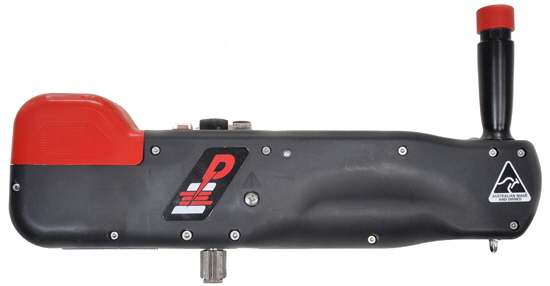 This Powerwincher review has been temporarily suspended, due to a malfunction with the red power button on the handle of the machine that was given to me, for the purpose of reviewing the product. The author asked the manufacturer, in writing, if they have a warranty repair facility in the US capable of evaluating the fault, but which they neglected to answer. It is therefore presumed that they have no such facility, and shipping the heavy machine back to Tasmania where it was made, is the astounding cost of some $500 via DHL- depending where it is shipped from in the US. The company's warranty does not address who should pay this return cost, the customer or the manufacturer, and this has so far prevented the inspection of the power button malfunction.
This Powerwincher review has been temporarily suspended, due to a malfunction with the red power button on the handle of the machine that was given to me, for the purpose of reviewing the product. The author asked the manufacturer, in writing, if they have a warranty repair facility in the US capable of evaluating the fault, but which they neglected to answer. It is therefore presumed that they have no such facility, and shipping the heavy machine back to Tasmania where it was made, is the astounding cost of some $500 via DHL- depending where it is shipped from in the US. The company's warranty does not address who should pay this return cost, the customer or the manufacturer, and this has so far prevented the inspection of the power button malfunction.
The warning below has therefore been posted here and other locations, alerting to the potential of a serious accident to someone being hoisted up a mast with this machine. When the issue is resolved it will be posted here.
WARNING ABOUT MAST HOISTING: After the Powerwincher review was written and published on the web and in international periodicals, the following event occurred on April 1st 2024 and was reported to the manufacturer the same day:
Whilst hoisting the 140 lbs square-sail yard up the track on the front of Britannia’s foremast, using a horizontally mast-mounted non-self-tailing-winch and with the line tailed by an assistant, the red power button jammed in the on-position, causing the machine to continue turning. This happened twice and the button had to be physically flipped with a finger to stop the winch rotating. It is therefore cautioned that the Powerwincher SHOULD NOT be used to hoist anyone up a mast.
All the reviews of the Powerwincher product by the writer were written prior to the malfunction. Therefore the writer, having posted this notice on the internet, and having informed relevant boating magazines, accepts no responsibility or liability for any subsequent injury or damage when using this product.
ROGER HUGHES
21st May 2024.
Winch winders are primarily intended for use on self-tailing winches, and it can be quite difficult to single-handedly tail the line from a non-self-tailing winch while operating a wincher with one hand. An assistant should always tail the line on non-self-tailing winches.
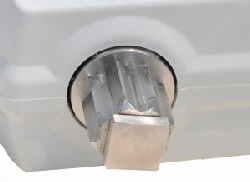 When using any winch-winder in a horizontally mounted winch it is doubly important that the winding sprocket locks into the winch, like most modern manual winch handles. If it is not locked it is possible that the 1” inch long sprocket could slip out of the winch while it is winding. I know this from experience with the Winchrite, because the drive sprocket does not lock into the winch, or even on the machine itself. It relies on a spring loaded button to hold the sprocket in place on the machine, much like a regular socket wrench handle. This is not an issue on vertically mounted winches, because the weight keeps the machines in the winch.
When using any winch-winder in a horizontally mounted winch it is doubly important that the winding sprocket locks into the winch, like most modern manual winch handles. If it is not locked it is possible that the 1” inch long sprocket could slip out of the winch while it is winding. I know this from experience with the Winchrite, because the drive sprocket does not lock into the winch, or even on the machine itself. It relies on a spring loaded button to hold the sprocket in place on the machine, much like a regular socket wrench handle. This is not an issue on vertically mounted winches, because the weight keeps the machines in the winch.
For continuous use, like in racing, two batteries are advisable for any wincher, then as one runs down it can be instantly replaced with a fully charged one.
All the winchers will spin a winch faster and for a lot longer than even the strongest crew member can sustain, and for those who sail single or even short-handed one would be invaluable to reduce effort in so many ways. Having one on a sailboat at any time, irrespective of your age or strength can save a lot of aches and pains.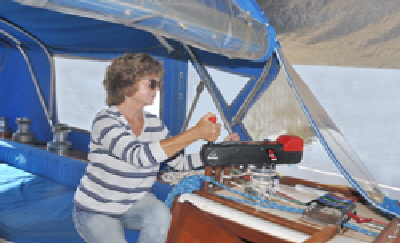 They will haul a mainsail or jib up in a jiffy, and if you have roller furling sails you can rapidly reef or furl a large main, jib, or Genoa. They will trim a sheet as hard as you like, but that can actually cause a problem if you're not careful, because it is easily possible to snap a line, break a running block, or damage a sail. Of course, this also applies to the very powerful deck mounted electric winches as well.
They will haul a mainsail or jib up in a jiffy, and if you have roller furling sails you can rapidly reef or furl a large main, jib, or Genoa. They will trim a sheet as hard as you like, but that can actually cause a problem if you're not careful, because it is easily possible to snap a line, break a running block, or damage a sail. Of course, this also applies to the very powerful deck mounted electric winches as well.
Using a portable electric wincher, young people and women can now do any of the winch winding jobs just as well as the men. Furling Britannia’s large squaresail takes 19 turns of the rope deck winch, (Britannia is a brigantine schooner), which my wife can now do in 40 seconds.
If you don't have an anchor windlass or just a hand cranked one, simply run the rode back to a mast or cockpit winch, or use a rope with a chain claw to haul the chain, and you now have a powerful electric windlass.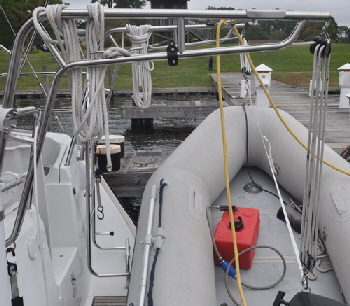 If you hoist your dinghy up on davits using tackles you can now forget that slow hand-hauling torture. Just run the hoists through blocks to a winch - even if that means extending the hoisting lines to a cockpit winch – and these amazing machines will effortlessly whiz the ‘dink’ up in no time, even with the outboard attached! It's so easy that I always hoist mine at night at anchor, to prevent theft.
If you hoist your dinghy up on davits using tackles you can now forget that slow hand-hauling torture. Just run the hoists through blocks to a winch - even if that means extending the hoisting lines to a cockpit winch – and these amazing machines will effortlessly whiz the ‘dink’ up in no time, even with the outboard attached! It's so easy that I always hoist mine at night at anchor, to prevent theft.
All the modern winch winders employ “soft-start” motors. These always start turning slowly irrespective of the speed settings, then speed up. There is therefore very little “grab” like on the start of some electric drills.
Another way to use the Ewincher2 is as a manual assist handle. Isaac Newton's third law states that; for every action, there is an equal and opposite re-action. This opposite reaction force can be quite strong when a wincher is winding hard, but if you just wind the handle at the same time like you would a normal manual handle Sir Issac's contra-rotating force will be much reduced. This is a bit like power assisted steering in a car, that makes turning the wheel much easier. It is not really possible using a Winchrite, because of its flat configuration, or the Milwaukee due to 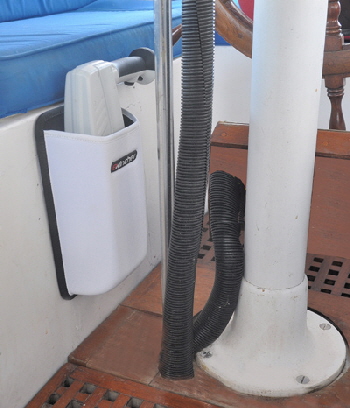 its size and handle position.
its size and handle position.
Storage cradles are available for all the winders, for mounting somewhere where everyone knows where to find it. It would be an expensive disaster if the wincher were to fall overboard on a sudden lurch of the boat, because they definitely do not float! A hand strap is supplied with the Ewincher2, just in case...
Once you own an electric wincher you can transfer your investment from boat to boat, unlike all those other expensive permanent gadgets you fitted, and had to leave for the new owner.
An electric wincher has certainly improved our sailing enjoyment by taking over the winch winding tasks, and enabling my wife to do some of them. The only disadvantage is that my biceps have now become even weaker, through lack of exercise.
WARRANTIES:
The warranty is two years on all the current battery operated models, limited to the first purchaser only, but that is about where the similarities end. All the machines can impose heavy loads on lines, sails, and the winch-winder itself, and shifting the machine around on a heaving sailboat can easily result in damage. Both Ewincher and Powerwincher are overseas companies who have different warranty conditions, much of which seems to be dictated by their national consumer laws. It is worth noting that Ewincher2 is the only warranty that pays for shipping back to France, or the US dealer from where it was bought.
COSTS:
At the time of writing, the Ewincher2 is $1,999 plus $30 shipping. There is a special edition kit called the Ewincher-SE which consists of just the Ewincher, a charger and a cradle in a carrying bag, for $1,650. If you want a second battery it is an extra $290.
The Winchrite is $973 including a cradle and shipping within the US.
www.Sailology.com (Winchrite).
www.Ewincher2.com
21st May 2024.